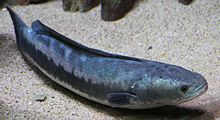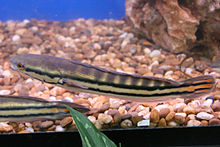- Giant snakehead
-
Giant PE Conservation status Not evaluated (IUCN 3.1)Scientific classification Kingdom: Animalia Phylum: Chordata Class: Actinopterygii Order: Perciformes Family: Channidae Genus: Channa Species: C. micropeltes Binomial name Channa micropeltes
(Cuvier, 1831)The giant snakehead or giant mudfish (Channa micropeltes) is the largest in the family Channidae, capable of growing to over 1 meter in length (3.3 feet) and a weight of over 20 kilograms (44 pounds). It is widely distributed in the freshwater of South East Asia and some regions of India. Other names include red snakehead, redline snakehead, Malabar snakehead, and Ikan toman (where ikan is "fish" in both Indonesian and Malay). The giant snakehead is known in Thai language as Pla Chado (Thai: ปลาชะโด).[1]
Contents
Biology
The young of the giant snakehead are red in color, with orange and black lateral stripes appearing after about two months. As the giant snakehead matures, they lose their stripes and redness, and instead develop a bluish black and white pattern on their upper body. Juveniles sold in the aquarium fish trade are commonly called red snakeheads.
 2cm long fry. Its color when young explains another of its names, the red snakehead.
2cm long fry. Its color when young explains another of its names, the red snakehead.
 After Bleeker, 1878; juvenile. USGS 2004[2]
After Bleeker, 1878; juvenile. USGS 2004[2]
Being a high level predator means that the giant snakehead eats almost everything in its way such as fish, amphibians and even small birds, but is not preyed upon by many other species because of the snakedhead's feared reputation. The giant snakehead is considered gregarious, with the young often following their mother closely. There have been reports of protective mother giant snakehead attacking men who have disturbed the snakehead's school of juveniles.
The species has the ability to crawl onto land and breathe air, although they are only able to do this in muddy or swampy areas, hence the nickname "mudfish".
Its ability to breathe air using a primitive lung located just behind the gills allows it to survive in stagnant water where oxygen levels are low, by coming to the surface and taking a small gulp of air. It also enables the snakehead to travel short distances on land, although it is unable to hunt while on land, as it cannot support itself at all with its small fins in comparison to its large body.
Use as food
In Malaysia and Singapore, known locally as the toman, while in Indonesia are called gabus or haruan (not to be confused with another species of smaller snakehead known as the common snakehead also called haruan), are cultured in fish ponds and reservoirs as game fish because they put up a strong fight when hooked. The giant snakehead is also a good food fish, and is often served in Chinese restaurants.
In Thailand this fish is prepared in a variety of ways, especially barbecued, being a common food item offered by street vendors.
In various Asian cultures it is believed that eating this fish will help in healing of the body, for example, after an operation or severe cuts and scrapes.
In Aquarium
The giant snakehead, normally called red or redline snakeheads are a popular fish to be sold in the pet trade. They are commonly sold as juveniles as pets. Some are even sold as feeders to be fed to larger carnivorous fish. Generally peaceful while young, they grow into voracious predators that will chase and eat anything that fits in their mouth. Due to this they are mostly called "freshwater great whites". However, they can successfully be housed with silver arowanas, clown knife fishes, oscars, and other fish from said size group.
Distribution
 Distribution of Channa striata. Source: USGS 2004[2]
Distribution of Channa striata. Source: USGS 2004[2]
The giant snakehead is found in Vietnam, Indonesia, Laos, Thailand, Malaysia, India, and possibly Burma. It has an oddly disjunctive distribution, inhabiting both Southeast Asia and southwest India, about 2500 km apart. It is theorized that the Indian population may be from an early human introduction, prior to the 19th century. In India it is found in southern Tamil Nadu and Kerala especially in Pechipparai, Chittar I & II, Neyyar and Temnalai Reservoirs. Ebanasar (1995) reported its distribution and Biology from these reservoirs.[3][4]
Ebanasar (1995) has also conducted series of experiments on the biology, physiology and culture of this fish. It is reported that this fish is highly suitable for cage culture and culture in ponds in combination with tilapia. It is found to be an effective tool in controlling the overpopulation of tilapia and thus checks stunted growth of tilapia.
There have been reports of the giant snakehead in already six of the US states including Wisconsin, Maryland, and parts of Virginia.
As an invasive species
In 2002 and 2003, three specimens were caught in Maryland, USA all believed to have been released pets. In 2003, a giant snakehead was caught in Rock River, Wisconsin.[5] Biologists were concerned that warmwater effluents could allow the tropical species to survive in the colder climate.
In 2010, a giant snakehead was found dead on the shores of the St. Charles river, in Quebec City (Canada). It was obviously an aquarium release.[6]
Hoax
In 2008, a specimen of C. micropeltes was reportedly caught by an angler while fishing for pike on the River Witham in Lincolnshire, England. The claim of this catch is highly peculiar as it was reportedly caught in late winter, and, being a tropical species it would not have been able to survive, let alone feed in an English river during winter.[7] A source within the Environment Agency was quoted as saying “The reaction was, 'Oh s***'. This is the ultimate invasive species — if it starts breeding here it's a disaster."[8] However, it was later determined to be a hoax; the fish had actually been found dead in a street.[9][10]
References
- ^ Fishing in Thailand (Thai)
- ^ a b Courtenay, Jr., Walter R. and James D. Williams. Chiana Micropeltes USGS Circular 1251: Snakeheads (Pisces, Chinnidae) - A Biological Synopsis and Risk Assessment. U.S. Department of the Interior, U.S. Geological Survey. 2004-04-01. Retrieved 2007-07-15.
- ^ Ebanasar, J. 1995. "Studies on some aspects of the Culture of murrels Channa micropeltes, Channa marulius and Channa striatus." PhD Thesis University of Kerala.
- ^ Ebanasar, J. and V. Jayaprakas. 1995. "Cage culture a conservation strategy for an endangered murrel Channa micropeltes." Proceedings of Seventh Kerala Science Congress.
- ^ Giant snakehead found in Wisconsin waters (News item). U.S. Department of the Interior, U.S. Geological Survey, Non-indigenous Aquatic Species program. 2003-09-19. Retrieved on 2007-07-16.
- ^ http://www.mrnf.gouv.qc.ca/presse/communiques-detail.jsp?id=8207
- ^ Chew, M. K. (2008-02-19). "Attack of the killer fish?". New Scientist 301: pp. 52. doi:10.1126/science.1085274. http://www.newscientist.com/blog/shortsharpscience/2008/02/attack-of-killer-fish.html. Retrieved 2008-02-20
- ^ Eel-Er, Virginia (2008-02-18). "Psycho predator is Sid Fishious". The Sun (London). http://www.thesun.co.uk/sol/homepage/news/article817553.ece.
- ^ Clarke, Matt (April 2008). "Snakehead catch 'a hoax'". Practical Fishkeeping.
- ^ Webster, Roy (2008-03-05). "Picture perfect haul delights Harris". Norfolk Eastern Daily Press. http://new.edp24.co.uk/content/sport/story.aspx?brand=EDPOnline&category=Sport&tBrand=EDPOnline&tCategory=Sport&itemid=NOED04%20Mar%202008%2020%3A36%3A20%3A940. Retrieved 2008-04-01.
Further reading
Ebanasar, J. and V. Jayaprakas. 1995a. Cage culture a conservation strategy for an endangered murrel Channa micropeltes. Proceedings of VII Kerala Science Congress, Palakad. pp 104–107
Ebanasar J. and V.Jayaprakas 1995b. Culture of three species of murrels with mossambique tilapia at three predator-prey densities in earthen ponds. J. Aqua . Trop. 10: 221-229.
Ebanasar J. and V.Jayaprakas 1996. Food utilization of Channa micropeltes (Channidae: Pisces) fed three diets of animal origin. Indian J. Exp. Biol. 34:1261–1264.
Ebanasar J. and V. Jayaprakas 2000 Influence of predator size on satiation and gastric evacuation of a predatory fish Channa micropeltes. Indian Journal of Comparative animal Physiology 18 : 44-55
Ebanasar, J. and V. Jayaprakas. 2000. Feeding ecology of Channa micropeltes from Pechipparai reservoir. Recent trends in life sciences, Trivandrum. Abstracts pp 89.
Ebanasar, J., B.D.Sheeja and R.Narayanan 2001. Nutritive value and Bio-chemical composition of selected freshwater fishes. Journal of Social Medicine 55-57.
Ebanasar. J and V. Jayaprakas (2003) Growth and food utilization of Juvenile giant murrel Channa marulius and striped murrel Channa striatus fed with diets of animal origin. Symposium on physiological approaches to conserve biodiversity and to tackle environmental health hazards. Indian Society for comparative animal physiology. Tirupati.
Jayaprakas. V and J.Ebanasar (2003) Enzymes activity in the alimentary canal of malabar snake head Channa micropeltes fed with different diets. Symposium on physiological approaches to conserve biodiversity and to tackle environmental health hazards. Indian Society for comparative animal physiology. Tirupati.
Ebanasar J and V. Jayaprakas (2005) Length weight relationship of the Malabar snakehehead Channa micropeltes from Pechipparai reservoir, Kanyakumari District, Tamil Nadu J. Inland Fish. Soc. India 37(1): 60-63External links
- Froese, Rainer, and Daniel Pauly, eds. (2006). "Channa micropeltes" in FishBase. April 2006 version.
- snakeheads.org
- Report of giant snakehead captured in Wisconsin
- Photos of Snakehead Fish
Categories:- Channidae
- Invasive animal species
- Fauna of Southeast Asia
- Fish of Thailand
- Fauna of India
- Animals described in 1831
Wikimedia Foundation. 2010.


